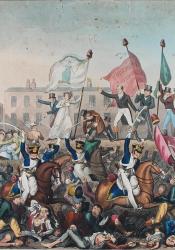Battle of Peterloo
August 16, 1819, began as a peaceful day of assembly as 60,000 (it is important to note that this is an approximate number of attendance due to the limited documentation of the event) people gathered to protest and demand reforms. This time in England's history was quite drab, most were unemployed and food prices were unattainable to most. Henry Hunt was a radical leader who wanted the gathering to show the discontent and resentment the people had towards the current holders in parliament. Out of the 60,000 a high number of those people were women and children who felt as though they were not getting the life that they deserved, no representation, and no food on the table. None of these people were armed or even considered dangerous, that being said the magistrates were intimidated and alarmed by the sheer size of the gathering and ordered the yeomanry (men in the British reserve) to arrest and detain the protesters. Many of these volunteer soldiers were untrained and did not hold back on seizing the leaders, wielding their sabres, and making a general attack on the crowd. This led to more soldiers being asked to join the few yeomanry by the Magistrates, causing the crowd to disperse within minutes, all were cleared from the fields, all except for the bodies left behind. Due to multiple accounts of the event, the exact number of deaths is not 100% accurate, the estimated deaths range from 9-11 killed and probably 500 injured. Hunt was one of the leaders captured, sentenced to prison for 2 years after being arrested, tried, and convicted. His conviction, however, was not in vain. These people gathered to emphasize how extending the vote to working men can and would have many positive outcomes. Some of which consist of fairer taxes, an end to restrictions on trade ( which was causing unemployment), and more efficient use of public money). It is important to note that there were very few who were there to argue the right women have to vote. Although many of these female reformers attended dressed in white as a symbol of their virtue, a symbol also worn by none other than Henry Hunt himself. Although uninjured, the white hat that he bore during this time became the symbol of reform. Peterloo became ground zero for popular radicalism and later on, popular Liberal politics. 1 day in British history had a lake effect that rippled into the people, one outcome was the creation of the Manchester Guardian, a newspaper that voiced the concerns for the liberal reformists. Two years after the Peterloo Massacre, on May 5, 1821, it published its first issue. It brought foreign affairs to the eyes of those not yet laid upon, liberal stances that rallied the reformers to inspire change, all of these events unraveled due to a single day. One that changed lives forever. The effects of that day have rolled into history as the day political reform was deemed necessary by the people, which later would cause the Reform acts of 1832, 1967, and 1884. These bills allowed the electorate for the House of Commons to expand past the inequalities of representation it previously knew and welcomed more representation throughout parliament, providing a more democratic solution.
British Library, https://www.bl.uk/romantics-and-victorians/articles/the-peterloo-massacre.

